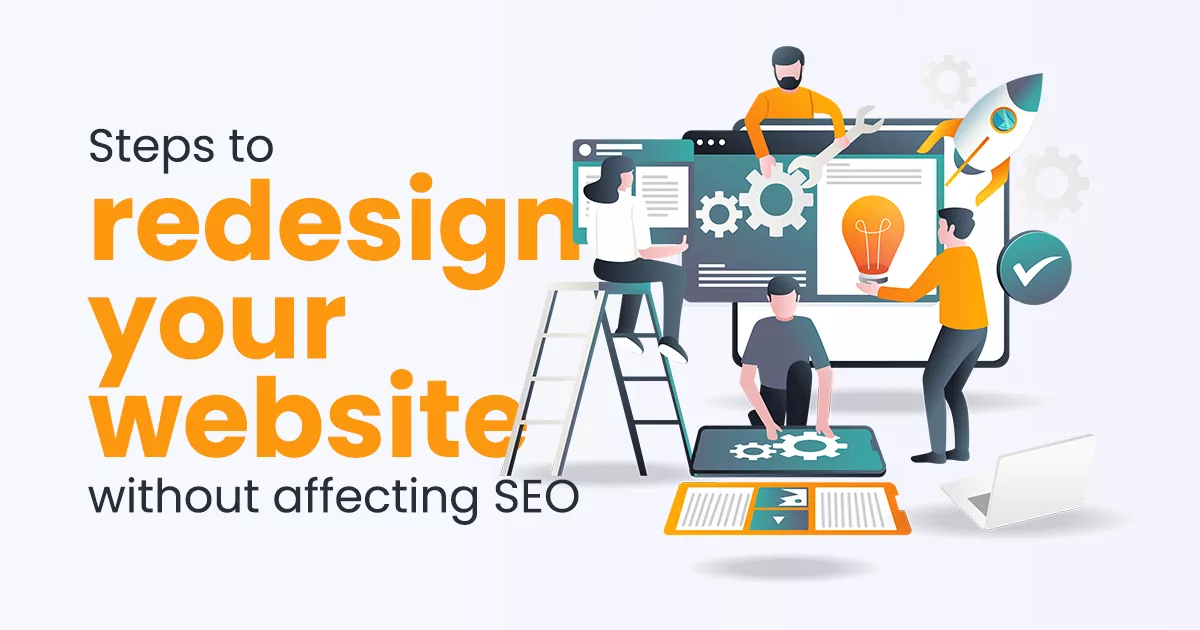How To Redesign Your Website Without Affecting SEO

The need to refresh and revitalize your website is inevitable in the ever-evolving digital landscape. However, the prospect of a redesign can be daunting, especially when considering the potential impact on your hard-earned SEO rankings.
Fortunately, with strategic planning and meticulous execution, it’s possible to breathe new life into your website without adversely affecting your SEO performance. In this blog, we’ll explore how to redesign a website without losing SEO.
How To Redesign A Website Without Losing SEO
1. Conduct a Comprehensive SEO Audit: Lay the Foundation
Conduct a thorough SEO audit before embarking on a website redesign to gain insights into your current performance. Identify high-performing pages, assess keyword rankings, and analyze the site structure.
-
Crawl Your Site:
Utilize tools like Google Analytics, Google Search Console, and third-party SEO tools to crawl your site. Identify issues such as broken links, duplicate content, and indexing problems.
-
Keyword Analysis:
Assess the keywords that are driving traffic to your site. Identify primary and secondary keywords, and prioritize them based on relevance and search volume.
By understanding your current SEO standing, you can develop a roadmap for the redesign process, ensuring that positive aspects are retained and weaknesses are addressed.
2. Preserve Your URL Structure: Maintain Continuity
Changing URLs can have a significant impact on your SEO rankings, as search engines use URLs to index and rank your pages. It’s crucial to preserve your existing URL structure to maintain continuity for both users and search engines.
-
301 Redirects:
Implement 301 redirects for any URL changes. This signals to search engines that the content has permanently moved to a new location, preserving the SEO value of the old URL.
-
Retain Keywords in URLs:
If your current URLs contain relevant keywords, try to retain them in the new structure. This provides continuity and reinforces the relevance of your content.
By keeping your URL structure intact, you minimize disruptions to your SEO rankings and ensure a smooth transition for both users and search engines.
3. Prioritize Mobile Responsiveness: Cater to User Experience
In the age of mobile-first indexing, prioritizing mobile responsiveness is not just beneficial for user experience but also a crucial factor in SEO rankings.
-
Responsive Design:
Choose a responsive design that adapts seamlessly to various devices, including smartphones and tablets. Google favours mobile-friendly websites in its rankings.
-
Page Speed:
Optimize your website for fast loading times on mobile devices. Google considers page speed a ranking factor and a slow-loading site can result in lower rankings.
E-commerce website developers in Jaipur specialize in creating responsive and mobile-friendly designs, ensuring that your website meets the latest industry standards.
4. Maintain Content Relevance: Enhance and Update
Content is the backbone of SEO, and maintaining content relevance during a redesign is paramount. Enhance and update your content to align with both user expectations and search engine algorithms.
-
Content Audit:
Evaluate your existing content and identify pages with high engagement and those that may need improvement. Update outdated information and improve content quality.
-
Keyword Integration:
Ensure that your target keywords are seamlessly integrated into your content. However, prioritize natural language and readability over keyword stuffing.
-
Alt Text for Images:
Optimize image alt text to improve accessibility and provide search engines with additional context for indexing.
By maintaining content relevance, you not only preserve SEO rankings but also enhance the user experience, contributing to improved organic search performance.
5. Implement SEO-Friendly Design: Collaborate with Developers
Collaboration with eCommerce website developers in Jaipur is instrumental in implementing an SEO-friendly design. Work closely with developers to ensure that the redesign aligns with search engine best practices.
-
Clean Code:
Optimize the website’s code for cleanliness and efficiency. Clean code contributes to faster loading times and enhances search engine crawling.
-
Structured Data Markup:
Implement structured data markup to provide search engines with additional information about your content. This can enhance the visibility of rich snippets in search results.
-
SEO Plugins and Tools
If using content management systems (CMS), leverage SEO plugins and tools to simplify the optimization process. Ensure that these tools are updated to their latest versions.
By incorporating SEO best practices into the design phase, you set the foundation for long-term search engine success.
6. Test Rigorously: Iron Out Any Issues
Testing is a critical phase in the website redesign process. Rigorously test the redesigned website to identify and address any issues that could impact SEO performance.
-
Cross-Browser Compatibility:
Test the website across different browsers to ensure consistent performance. Browser inconsistencies can lead to user experience issues.
-
Mobile-Friendly Testing:
Utilize mobile-friendly testing tools to confirm that the redesign is optimized for various mobile devices.
-
404 Error Checks:
Monitor for 404 errors and address them promptly. Implement custom 404 pages that guide users and search engines to relevant content.
E-commerce website developers in Jaipur excel in comprehensive testing procedures, ensuring that your redesigned website is free from technical glitches that could affect SEO.
7. Monitor and Analyze Post-Launch: Stay Proactive
Post-launch monitoring and analysis are crucial for identifying any unforeseen issues and gauging the impact of the redesign on SEO performance.
-
Google Search Console:
Regularly check Google Search Console for crawl errors, indexing issues, and any other notifications from Google regarding your website.
-
Analytics Tracking:
Monitor website analytics to assess the impact on traffic, user behavior, and conversions. Compare post-launch data to pre-launch benchmarks.
-
User Feedback:
Encourage user feedback and address any issues reported by visitors. A proactive approach to user concerns can prevent negative impacts on SEO.
By staying proactive and monitoring the website’s performance post-launch, you can quickly address any issues that arise and ensure a seamless transition for both users and search engines.
Conclusion
A website redesign doesn’t have to be a stumbling block for your SEO efforts. By following these strategic steps and leveraging the expertise of eCommerce website developers in Jaipur, you can breathe new life into your website while preserving and enhancing your SEO rankings. Jaipur’s tech community, renowned for its proficiency in web development and digital solutions, stands as a valuable ally in your quest for a successful website redesign.
Collaborate with eCommerce website developers in Jaipur to seamlessly blend design aesthetics with SEO best practices, ensuring that your redesigned website not only meets but exceeds user and search engine expectations. As you embark on the journey of website revitalization, let Jaipur’s tech prowess be the catalyst for achieving a harmonious balance between innovation and SEO success.
Subscribe to our Blog
Read our newly created blogs delivered straight to your inbox.


